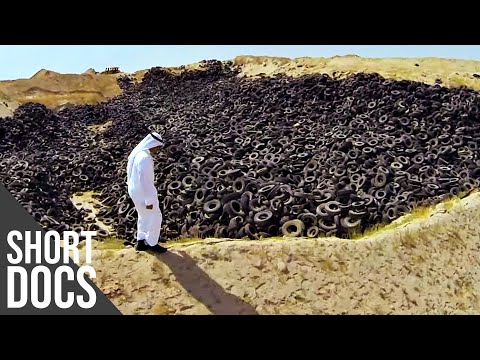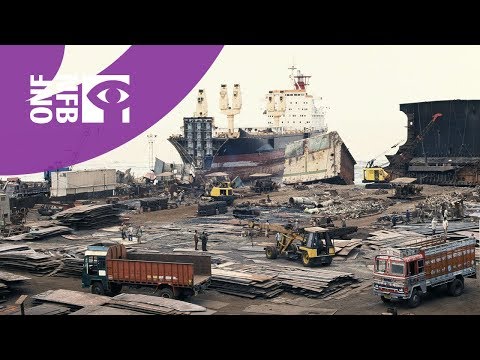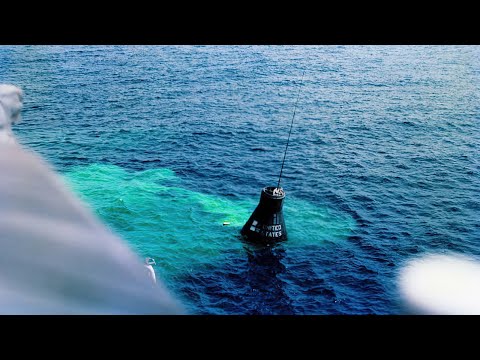That is why handling this industrial junk is a big challenge. After a while, certain types of industrial waste have become endemic to a few areas. These places receive a massive amount of that industrial junk from around the world every year. The situation is such that these places are now known for the type of useless waste dumped there. This list includes ten of the world’s most unique industrial graveyards, now famous for the industrial junk thrown there.
10 Tire Graveyard, Sulabiya, Kuwait
The first industrial junk graveyard on our list is so big that it is visible from space. And when seen from space, a black carpet-like mass is visible on the ground. This area in Kuwait holds more than 50 million tires. Anyone arriving at this place for the first time will start scratching their head, trying to understand where they collected this colossal number of tires from? The second question that will come to mind is why? The answer to the “where” question is that the tires came from Kuwait and the rest of the world. The answer to why is that from 1980 to 2001, Kuwait dealt in the business of importing used tires from the world—especially from the U.S. and Europe. Kuwait provided a space in its desert for other countries to throw their unwanted tire junk. But in two decades, the size of this rubber junk became so huge that Kuwait had to ban these imports in 2001. Now Kuwait is trying hard to dispose of the 50 million tires. It has started using recycling technology to make money from these tires, but the sheer quantity of tires outweighs any benefit as a resource. Frequent fires are reported in this tire graveyard, causing enormous environmental damage. These tire fires are also difficult to control and require considerable resources.[1]
9 Car Graveyard, Old Car City, Georgia, USA
Used cars fill the second industrial junk graveyard on our list. The cars here are vintage ones. And with 4,500+ cars and trucks, this is the world’s largest graveyard of vintage automobiles. Old Car City was opened in 1931 in Georgia, USA. The initial plan of this junkyard was to collect scrap metal from cars, and this became a main focus, particularly during WW2. But in later years, this junk haven became famous for its vintage car models. Most of the car models are from 1972 or earlier. Today, the junkyard also serves as an old car museum, containing more than 4,000 great American classic cars. It is a popular tourist place, with people from all over visiting to see its extensive vintage car collection.[2]
8 E-Waste Graveyard, Agbogbloshie, Ghana
E-waste forms the majority of industrial junk the 21st century produces. Ours is an age of smartphones, computers, and electronic devices. Modern-day consumerism promotes updating our smartphones and computers every year. This tendency leaves behind an ever-growing stockpile of old, discarded electronic devices, which otherwise were in perfect working order. About 50 million tons of e-waste gets created every year, and this enormous amount of e-waste cannot all be recycled. E-waste is accepted by technology companies if recyclable. But what cannot be recycled becomes a waste of space and liability and needs to be discarded. As often happens, wasteful developed countries need to find somewhere to dump their waste. And many times, that place is a less-developed country, usually in Africa or South America. In the case of e-waste, the country is Ghana. A wasteland area now, Agbogbloshie in Ghana has become the world’s biggest e-waste dumpsite. About 10,000 local workers work daily in this graveyard. Some e-waste of used goods gets sold in poor African countries at low prices. From other e-waste, the workers extract precious elements using acid, chemicals, and fire. This process badly affects the local population’s health because of the toxins released. Until a strong nation decides to shoulder responsibility, this e-waste graveyard will keep becoming more harmful to the human population. Despite being the source of thousands of livelihoods (and health problems), the government of Ghana leveled this site and the recycling center and market near it. Now, the work done with the tons of e-waste still coming in has now moved underground—closer to where people live, bringing the health risks home.[3]
7 Plastic Jungle Graveyard, Malaysia
In this next item on our list, we see the plastic jungle graveyard in Malaysia. Plastic waste is something very few countries like to keep on their land. Malaysia tried to sustain a business based on importing plastic waste from all over the world. Malaysia planned to convert that plastic waste into marketable products. So, very quickly, Malaysia became the plastic graveyard of the world. But like other countries on this list, the imported plastic waste became too much to handle for Malaysia. The benefits of importing plastic waste were reduced as the mountain of waste grew, the task of treating plastic waste becoming intimidating. As a result, Malaysia has started returning unwanted plastic waste to European countries. Now Malaysia is left with the daunting task of handling plastic waste stockpiles on its soil, but there is no easy solution for it. The more plastic waste remains, the more environmental problems it will cause.[4]
6 WWII Bombs Graveyard, Beaufort’s Dyke Submarine Trench
World War 2 was the last full-scale war that engulfed the entire world. There is no accurate count of the bombs dropped by both sides in the war. But after the end of WW2, getting rid of all those unexploded bombs became a headache for the allied nations. The United Kingdom government decided to use a natural submarine trench in their ocean waters for this task. This trench is called Beaufort’s Dyke, and it is a 50-kilometer-long (31-mile) trench in the North Channel’s water. This channel divides Northern Ireland and Scotland, and Beaufort’s Dyke sits right in between this channel. Since WW2, the UK has dumped about 1.15 million tons of conventional and chemical bombs in this trench. This figure makes it the largest bomb graveyard in the world. Unfortunately for the UK, it was discovered that the dumping did not start or end with WWII. It is believed the UK used this area from the 1920s until 1976. Weapons experts feel that this amount of unexploded artillery in one place is like a ticking time bomb—no pun intended. Because after years of corrosion, the shells of the bombs are more likely to corrode, potentially leading to explosions. Because of Beaufort’s Dyke, plans for a bridge between Ireland and Scotland have always been rejected. Also, sometimes the bombs from this trench wash up on the nearby coasts and cause problems. The world’s largest bomb graveyard can cause an explosion of unimaginable proportions if it ever triggers, so safe disposal of this graveyard is in the best interest of everyone.[5]
5 Alang Shipyard, Gujarat, India
There is a saying, “A mighty storm is inconsequential when facing a mighty ship.” But every mighty ship at one point has to call it a day. After a ship is decommissioned or no longer of use, it is often sent to various desolate shipyards around the world. In these yards, the past glory of the ship is ripped apart for the price of the metal. Ships get dismantled down to the last possible detail. Watch this video on YouTube Alang Shipyard in Gujarat, India, is one such graveyard for ships. Annually, 400–500 ships arrive at Alang for dismantling. The entire coastline of Alang has views of ships at different stages of dismantling. To a movie buff, these ships might look like Godzilla has half-eaten these ships. The sound of metal banging is the only sound echoing apart from the waves. The toxic waste from these ships is also a big problem in Alang as the toxic waste from the process has destroyed the marine life near the yard. Despite being a 100-billion-dollar industry, a visit to Alang evokes feelings of attending the funeral of a once-mighty ship.[6]
4 Clothes Dumping Site, Atacama Desert, Chile
The next item on our list is a unique graveyard in the Atacama Desert located in Chile. It is an uninhabited and barren desert situated close to the Chilean port city of Iquique. This graveyard is like the dead-end of the clothing supply chain. It receives about 60,000 thousand tons of unwanted clothing every year, with Chile being the largest importer of used clothing. About 40% of these used clothes are sold again in poor Latin American countries. However, the clothes that find no buyers—even by weight—will get dumped into the Atacama Desert. This clothing graveyard now has mountains of unused and discarded clothing. And these mountains keep growing as truckloads of clothes get dumped here every year. Some of these clothes are high-end fashion apparel, while others result from the devastating effects of fast fashion. This giant graveyard reflects the mindless consumerism of humans.[7]
3 Nuclear Waste Graveyard, Hanford Nuclear Site, Washington, USA
The next item on our list is the Hanford Nuclear Site, situated near the Colombia River in Washington State and spread over a 1,517-square-kilometer (586-square-mile) area. Through the Cold War, the Hanford Site produced plutonium for nuclear weapons. Two-thirds of the U.S. nuclear weapons have received plutonium from this facility. Now, this facility serves as a nuclear waste graveyard. At Hanford, about 56 million gallons of liquid nuclear waste lie in underground storage tanks. The solid waste lies buried underground, but it is still dangerous as it won’t lose its radioactivity for many years. There have been instances of storage tanks leaking radioactive waste. The employees working at the Hanford Site have reported getting deadly diseases like cancer after working here. Hanford is the largest nuclear waste graveyard in the world and could become a Chernobyl-like disaster if any nuclear spill happens.[8]
2 Spacecraft Graveyard, Point Nemo, Pacific Ocean
A space mission is a noble task and a symbol of human progress. But this noble cause also has problems of its own. Like all things in life, spacecraft have an end-cycle phase. In this phase, it creates spacecraft junk. The junk includes rockets that have ejected satellites or decommissioned and damaged spaceships. Not many people know what happens to defunct spaceships or satellites. One thing is sure: they cannot be left rotating around the earth. It would become a potential danger for future space missions. Therefore, a dumping site for spacecraft junk was required. For this purpose, scientists chose the most remote location on Earth. This exact location is called Point Nemo and lies in the Pacific Ocean. Point Nemo is the farthest from any landmass on Earth. According to scientists, the remoteness of this point made it the best choice for dumping space junk. A spacecraft reentering the earth’s atmosphere gets superheated, and the chance of its burning debris injuring anyone is least at Point Nemo. Any diver crazy enough to reach the Point Nemo sea bed will find many famous spaceships lying in peace.[9]
1 Glass Beach, Ussuri Bay, Russia
The last place on our list is a 67-kilometer-long (42-mile) bay area in the Great Gulf. For years this site was a dumping spot for the neighboring glass industry and locals throwing empty alcohol bottles. Truckloads of waste glass bottles were thrown in this bay, making it the glass dumping ground of the world. The thoughtless human behavior converted this beautiful bay into an unsightly dumping site. But then, like a savior, Mother Nature decided to step in. Now, this human-made mess has been turned into something stunningly beautiful. Using the tidal waves at the bay, with slow and steady erosion, nature turned these piercing glass pieces into colorful pebbles. This entire bay now looks like a rainbow has landed on it or like you are looking through a kaleidoscope. Ussuri Bay is now a famous tourist spot, where people come to see what miracle nature has done with the garbage thrown at it.[10]
























